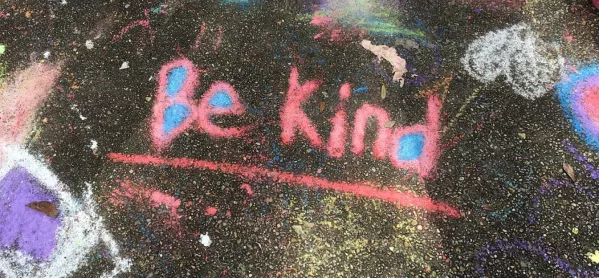
6 ways to put kindness at the heart of EYFS classrooms

The concept of kindness in the classroom is one heard a lot - but it can mean different things to different people.
For me, it is best expressed as an environment for children built on mutual respect and understanding, with a co-creation of knowledge and experiences together. This is now of even greater significance, given the disruption children have lived through in the past 12 months.
But how can we ensure that kindness is at the core of classroom practice? Here are six practical ways to create a truly kind classroom.
1. Demonstrate reciprocal respect
Everyone within a school should be greeted, thanked and considered an equal: the cleaner, the co-teacher and the learning support.
For example, whenever we pass the cleaners, I and the children acknowledge, stop and thank them for their jobs, which is most days. I openly thank the teachers for helping me and encourage the children to replicate this when they are helped with a task. This models appreciation for others’ kindness.
Furthermore, I ensure the children listen to one another when talking, explaining how, when we disrespect one another, this is unkind and hurts their peers’ feelings.
2. Discuss how to be kind
A great way to do this is to bring in texts which illustrate kind and unkind behaviour. Talk through and role-play how the narrative and outcomes could be changed depending on what is said.
You could share real-life (anonymous) class incidents and theoretical problem scenarios, with puppets or role-play, and ask the children to discuss them with a partner.
I try to encourage the children to pick apart the problem and work out ways to support the individual to change their behaviour.
3. Celebrate ‘kind acts’
Kind acts should be pointed out often to build a culture of kindness. Very quickly, children try to show they can be kind, too.
For example, after play, focus on kind acts that took place at playtime. Children can nominate one another for something kind they did, such as taking a friend to the nurse, cheering up a friend who is sad or playing with someone who was alone. As this is a form of praise, this behaviour will likely be repeated.
A “kindness tree” - where children can draw around their hand on paper and illustrate a kind act a friend has done for them - can be a good way to do this.
After this discussion, they can add their “leaf” to the tree. It is also nice to review the leaves regularly to remind children of the kind acts that have taken place in class.
4. Talk through moments of unkindness
Following on from point 2, when children are disrespectful or unkind in the classroom, allow them time to think and talk through their choices.
Do not apply negative consequences but attempt to find the underlying cause and triggers by providing support and assurance that they are allowed to make mistakes.
When mediating, highlight the feelings of all involved, including the whole class if applicable, so a clear understanding of why a certain behaviour was unkind is developed.
5. Develop an ‘emotions chart’
You can also establish a class “emotions chart”, with images to pinpoint their feelings. Print out photos or the children’s names and encourage them to place themselves next to their current feeling.
Encourage the children to regularly update where they are emotionally on the chart.
This boosts kindness, as both staff and children can quickly identify the children who may feel sad, worried or anxious, and have a quick discussion with them.
6. Emphasise mistakes as learning opportunities
Children are quick to pick up on and tease each other if they feel someone else has made a mistake, but being laughed at by another child can be devastating to a child who has volunteered an answer.
Illustrate your own mistakes and purposely make them, often, to show how you are not perfect.
It is important that we show it is OK not to know something and to ask questions.
For example, when learning about birds, I asked our resident expert (a child very interested in animals) to name some “raptors”, as I only knew one.
When writing words in phonics, I make purposeful mistakes, which the children correct and then tell me the rule. When I don’t know something, we all research it together on Google. I always discuss how I learn with them.
What I love about a culture of kindness is that it rubs off. My colleagues bounce back and forth celebrating, displaying and highlighting kindness. Throughout our unit, there is a genuine warmth and connection - something that can only come about through the principles we teach and practice.
Jessica Gosling is a teacher at the Taipei European School. She can be contacted via her website or Twitter @JessGosling2
You need a Tes subscription to read this article
Subscribe now to read this article and get other subscriber-only content:
- Unlimited access to all Tes magazine content
- Exclusive subscriber-only stories
- Award-winning email newsletters
- Unlimited access to all Tes magazine content
- Exclusive subscriber-only stories
- Award-winning email newsletters
You need a subscription to read this article
Subscribe now to read this article and get other subscriber-only content, including:
- Unlimited access to all Tes magazine content
- Exclusive subscriber-only stories
- Award-winning email newsletters
- Unlimited access to all Tes magazine content
- Exclusive subscriber-only stories
- Award-winning email newsletters